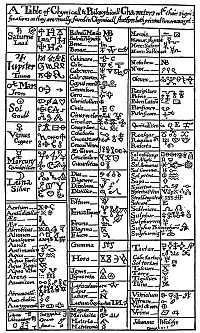Classical planets in Western alchemy

Alchemy in the Western World and other locations where it was widely practiced was (and in many cases still is) allied and intertwined with traditional Babylonian-Greek style astrology; in numerous ways they were built to complement each other in the search for hidden knowledge (knowledge that is not common i.e. the occult). Astrology has used the concept of classical elements from antiquity up until the present day today. Most modern astrologers use the four classical elements extensively, and indeed it is still viewed as a critical part of interpreting the astrological chart.
Planets and metals

Traditionally, each of the seven "planets" in the solar system as known to the ancients was associated with, held dominion over, and "ruled" a certain metal (see also astrology and the classical elements).
The list of rulership is as follows:
- The Sun rules Gold (
 )
) - The Moon, Silver (
 )
) - Mercury, Quicksilver/Mercury (
 )
) - Venus, Copper (
 )
) - Mars, Iron (
 )
) - Jupiter, Tin (
 )
) - Saturn, Lead (
 )
)
As other solar system bodies including Uranus, Neptune, and the former planets Ceres, Pallas, Juno, Vesta, Pluto and the centaurs were not discovered until relatively recently, there is no classical or traditional basis for these associations as there is for the ancient planets and metals. The metals were named after the planets instead of the metals dominating the planets.